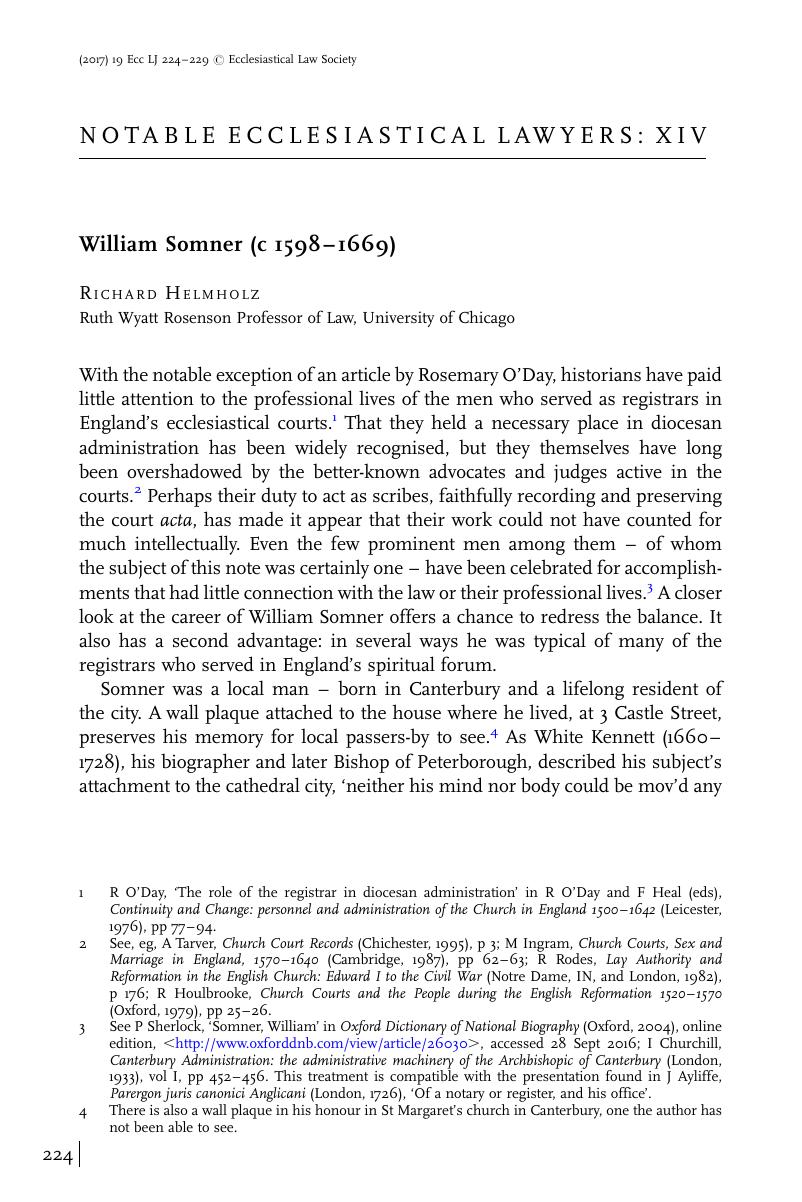No CrossRef data available.
Article contents
William Somner (c 1598–1669)
Published online by Cambridge University Press: 02 May 2017
Abstract

- Type
- Notable Ecclesiastical Lawyers: XIV
- Information
- Copyright
- Copyright © Ecclesiastical Law Society 2017
References
1 O'Day, R, ‘The role of the registrar in diocesan administration’ in O'Day, R and Heal, F (eds), Continuity and Change: personnel and administration of the Church in England 1500–1642 (Leicester, 1976), pp 77–94Google Scholar.
2 See, eg, Tarver, A, Church Court Records (Chichester, 1995), p 3Google Scholar; Ingram, M, Church Courts, Sex and Marriage in England, 1570–1640 (Cambridge, 1987), pp 62–63 Google Scholar; Rodes, R, Lay Authority and Reformation in the English Church: Edward I to the Civil War (Notre Dame, IN, and London, 1982), p 176Google Scholar; Houlbrooke, R, Church Courts and the People during the English Reformation 1520–1570 (Oxford, 1979), pp 25–26 Google Scholar.
3 See Sherlock, P, ‘Somner, William’ in Oxford Dictionary of National Biography (Oxford, 2004)Google Scholar, online edition, <http://www.oxforddnb.com/view/article/26030>, accessed 28 Sept 2016; Churchill, I, Canterbury Administration: the administrative machinery of the Archbishopic of Canterbury (London, 1933), vol I, pp 452–456 Google Scholar. This treatment is compatible with the presentation found in Ayliffe, J, Parergon juris canonici Anglicani (London, 1726)Google Scholar, ‘Of a notary or register, and his office’.
4 There is also a wall plaque in his honour in St Margaret's church in Canterbury, one the author has not been able to see.
5 W Kennett, ‘Life of William Somner’, p 4, annexed to the beginning of Somner, W, Treatise of Gavelkind (second edition, London, 1726)Google Scholar.
6 A registrar's patent from the fifteenth century is printed in Woodcock, B, Medieval Ecclesiastical Courts in the Diocese of Canterbury (Oxford, 1952), p 123Google Scholar.
7 Kennett, ‘Life of William Somner’, p 7.
8 Somner, W, ‘Preface’ in Dictionarium Saxonico-Latino-Anglicum (Oxford, 1659, reprinted 1970), no 2Google Scholar.
9 See Kennett, ‘Life of William Somner’, p 39, remembering him as saying ‘I was necessitated to betake myself to other thoughts’ than the work of the ecclesiastical tribunals.
10 Somner, ‘Preface’, no 2. Little is known about his income during the Interregnum, but he was able to find at least occasional work as a notary: see J Houston, Catalogue of Ecclesiastical Records of the Commonwealth 1643–1660 in the Lambeth Palace Library (Farnborough, 1968), p 10.
11 The figures that follow were compiled from the manuscript Act book, Canterbury Cathedral Archives (henceforth CCA), Act book Z.2.1. For Brent's career, see Levack, B, The Civil Lawyers in England: a political study (Oxford, 1973), pp 212–213Google Scholar.
12 It is important to note, of course, that most cases required more than one sitting, so that the majority of cases heard in each session were continuations of those begun earlier.
13 Generally styled a surrogate, who in the majority of sessions was the Revd Edward Aldey, rector of the church of St Andrew, Canterbury.
14 The exception was the session of 24 May 1638, when Thomas Shindler acted ‘in absentia registrarii’.
15 It is found in Scott, W and Bliss, J (eds), Works of the Most Reverend Father in God, William Laud, DD, 7 vols (Oxford, 1847–1857), vol VII, pp 268–269 Google Scholar.
16 Kennett, ‘Life of William Somner’, pp 9–10.
17 See Somner, W, Antiquities of Canterbury (London, 1640), pp 357–359 Google Scholar.
18 Ibid , referring to Decretals 1.24.1–4, and to Duarenus, F, De sacris ecclesiae ministeriis ac beneficiis (Paris, 1564)Google Scholar, lib I, c 8, but possibly taken from the edition also found in the Tractatus universi iuris.
19 See Lyndwood, W, Provinciale (seu Constitutiones Angliae) (Oxford, 1679), pp 14–15 Google Scholar, sv decanos rurales; Sylvester Prierias (Mazzolini) (1456–1523), Summa Sylvestrina (Bologna, 1515), sv archipresbyterii.
20 Somner, Antiquities, p 177, describing the proper procedure as ‘springing haply from these Laws in the Digest’, citing D.41.1.9 and D.18.1.74.
21 Ibid , p 485, citing D de Covarrubias, Liber practicarum quaestionum, vol II, c 31.
22 See Gray, C, The Writ of Prohibition: jurisdiction in early modern English law (New York, 1994)Google Scholar; Baker, J, Oxford History of the Laws of England: volume VI 1483–1558 (Oxford, 2003), pp 237–244CrossRefGoogle Scholar.
23 Kennett, ‘Life of William Somner’, p 55, stating that it was this work that ‘led him through a long course of Common Law and through the sense of very many Statutes’.
24 W Somner, Treatise of Gavelkind, both Name and Thing (London, 1660).
25 Eg, de Bracton, H, De legibus (London 1640)Google Scholar, Canterbury Cathedral Library W/C-3-7, pp 92, 311.
26 Ibid , p 373, correcting ‘Henrici regis senis’ to ‘Henrici regis senioris’.
27 Ibid , p 126 (Coke's Institutes), p 158 (Hengham's Summa), p 61 (Glanvill's Tractatus de legibus), p 26 (Cowell's Interpreter).
28 Ibid , p 105, on the several royal courts where ordinary litigation took place.
29 Lambeth Palace Library, London, MS 2014, no 10, f 150.
30 It is now CCA, Z.2.4.


